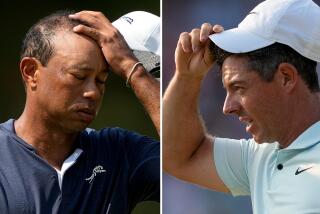Despite His Age, Kite Says Sky’s the Limit : Golf: PGA Tour’s all-time leading money winner thinks players reach their peak in mid-30s to early 40s.
- Share via
CARLSBAD — The adage that life begins at 40 would certainly be disputed by most aging professional athletes.
At that age, they’re usually out of sports and pursuing other endeavors, hoping they won’t be forgotten.
Not Tom Kite, who turned 40 last month, and claims his best playing years are still ahead.
Kite, who will play in the PGA Tour season-opening MONY Tournament of Champions starting today at La Costa, is coming off a fabulous year.
He was the tour’s leading money winner, earning a record $1,395,278 that elevated him to No. 1 on the all-time money winning list. He also was named PGA player of the year for the first time in a career that began in 1972.
As for his age? “Forty is better than 25 as far as being able to play,” Kite said. “You’re closer to being in your prime at 40 than you are at 25. I don’t think you come into your own until you get into the mid-30s.
“Everybody makes such a big deal out of this 40 business. It’s one day older. I feel I’m in as good a shape as I’ve ever been and, coming off the year I had, there is no way that I’m not going to approach this year as a very good year.”
Kite says that a pro golfer’s best years are from age 35 up to 44.
If so, Kite has reason to be enthusiastic about the future.
He is at the top of his game. The only thing missing in his resume is a championship in one of the four major tournaments: the U.S. Open, Masters, PGA championship or British Open.
But he said he is not setting any specific goals.
“I prefer to call them dreams and everyone knows what they’d be for anyone out here,” Kite said. “Once you reach the level that I am it’s pretty easy to imagine what those dreams are.”
There was, however, one major disappointment in an otherwise exceptional 1989 season for Kite. He failed to win the U.S. Open after leading by three strokes through four holes in the final round.
He then self-destructed, hitting his drive into water at the fifth and winding up with a 78.
Asked if he feels that the Open owes him one, Kite said:
“Nothing owes me anything out here. Golf is a funny game. It can be a cruel game and it can be very rewarding.
“I had the best year of my life, but in some ways it was the most disappointing.”
Mark Calcavecchia is ahead of schedule according to Kite’s estimate that pros don’t hit their stride until their mid-30s.
Only 29, the long-hitting Calcavecchia won three tournaments last year, including the British Open. Kite and defending T of C champion Steve Jones were the only other players to win three PGA Tour events last year.
Moreover, Calcavecchia was fifth on the money winning list with $807,741.
“I’m just going to try to keep improving,” he said. “If you keep improving on your year before, which I’ve done every year since 1985, sooner or later you’re going to run out of improvements.
“It’s going to be difficult to top 1989, but my goal is to do it.”
Asked if he has achieved more recognition since winning the British Open in a playoff with Australians Greg Norman and Wayne Grady, Calcavecchia said:
“It hasn’t changed me in terms of the way I am, but it’s changed the way people see me as a player. Now everybody considers me as a world-class player, which I am, but I might not have been recognized if I hadn’t won the British Open. I would have been just another good, young American tour player.”
Asked if he has any ambition to be the world’s best player, Calcavecchia said:
“I don’t know if I have the mental capability to do that right now. I just want to win tournaments. I’m not out there trying to be the world’s No. 1-ranked player. I don’t care if I’m eight, six, three, or 12. Those are just numbers on the list. The only numbers I want to have on a list are tournament wins.”
Golf Notes
Only winners of PGA Tour events, including the British Open, are eligible to compete at the 7,022-yard La Costa course. . . . First prize is $135,000. . . . Among the prominent players in the field are Curtis Strange, two-time U.S. Open champion; Payne Stewart, the PGA champion, and Greg Norman, a two-time winner in ’89.
More to Read
Go beyond the scoreboard
Get the latest on L.A.'s teams in the daily Sports Report newsletter.
You may occasionally receive promotional content from the Los Angeles Times.










